2015 NISSAN GT-R flat tire
[x] Cancel search: flat tirePage 205 of 358
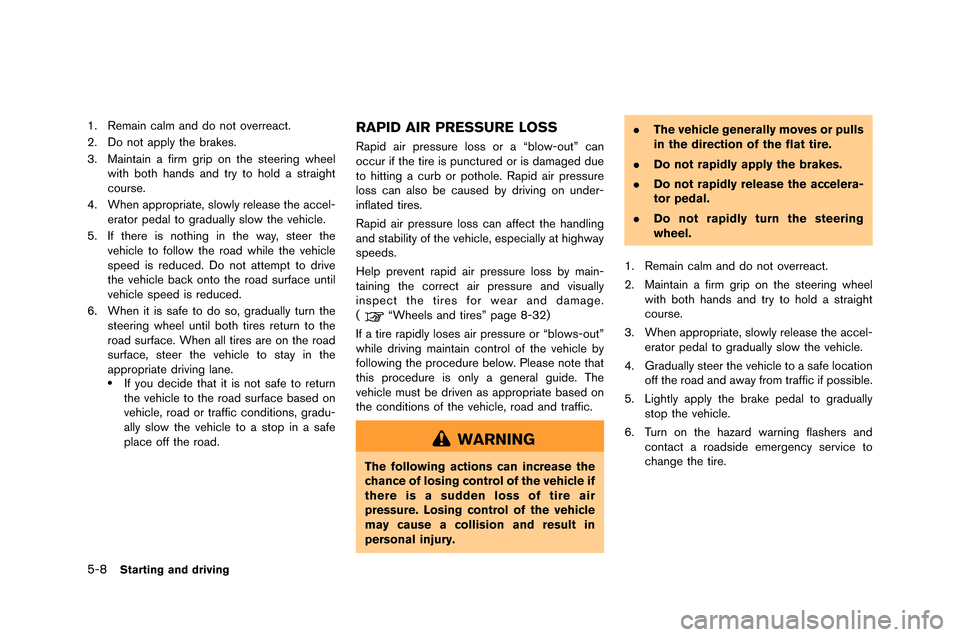
5-8Starting and driving
1. Remain calm and do not overreact.
2. �fo not apply the �brakes.
3. Maintain a firm grip on the steering wheelwith �both hands and try to hold a straight
course.
4. When appropriate, slowly release the accel- erator pedal to gradually slow the vehicle.
5. If there is nothing in the way, steer the vehicle to follow the road while the vehicle
speed is reduced. �fo not attempt to drive
the vehicle �back onto the road surface until
vehicle speed is reduced.
6. When it is safe to do so, gradually turn the steering wheel until �both tires return to the
road surface. When all tires are on the road
surface, steer the vehicle to stay in the
appropriate driving lane.
.If you decide that it is not safe to return
the vehicle to the road surface �based on
vehicle, road or traffic conditions, gradu-
ally slow the vehicle to a stop in a safe
place off the road.
RAPID AIR PRESSURE LOSS
Rapid air pressure loss or a “�blow-out” can
occur if the tire is punctured or is damaged due
to hitting a cur�b or pothole. Rapid air pressure
loss can also �be caused �by driving on under-
inflated tires.
Rapid air pressure loss can affect the handling
and sta�bility of the vehicle, especially at highway
speeds.
Help prevent rapid air pressure loss �by main-
taining the correct air pressure and visually
inspect the tires for wear and damage.
(
“Wheels and tires” page 8-32)
If a tire rapidly loses air pressure or “�blows-out”
while driving maintain control of the vehicle �by
following the procedure �below. Please note that
this procedure is only a general guide. The
vehicle must �be driven as appropriate �based on
the conditions of the vehicle, road and traffic.
WARNING
The following actions can increase the
chance of losing control of the vehicle if
there is a sudden loss of tire air
pressure. Losing control of the vehicle
may cause a collision and result in
personal injury. .
The vehicle generally moves or pulls
in the direction of the flat tire.
. Do not rapidly apply the brakes.
. Do not rapidly release the accelera-
tor pedal.
. Do not rapidly turn the steering
wheel.
1. Remain calm and do not overreact.
2. Maintain a firm grip on the steering wheel with �both hands and try to hold a straight
course.
3. When appropriate, slowly release the accel- erator pedal to gradually slow the vehicle.
4. Gradually steer the vehicle to a safe location off the road and away from traffic if possi�ble.
5. Lightly apply the �brake pedal to gradually stop the vehicle.
6. Turn on the hazard warning flashers and contact a roadside emergency service to
change the tire.
Page 210 of 358
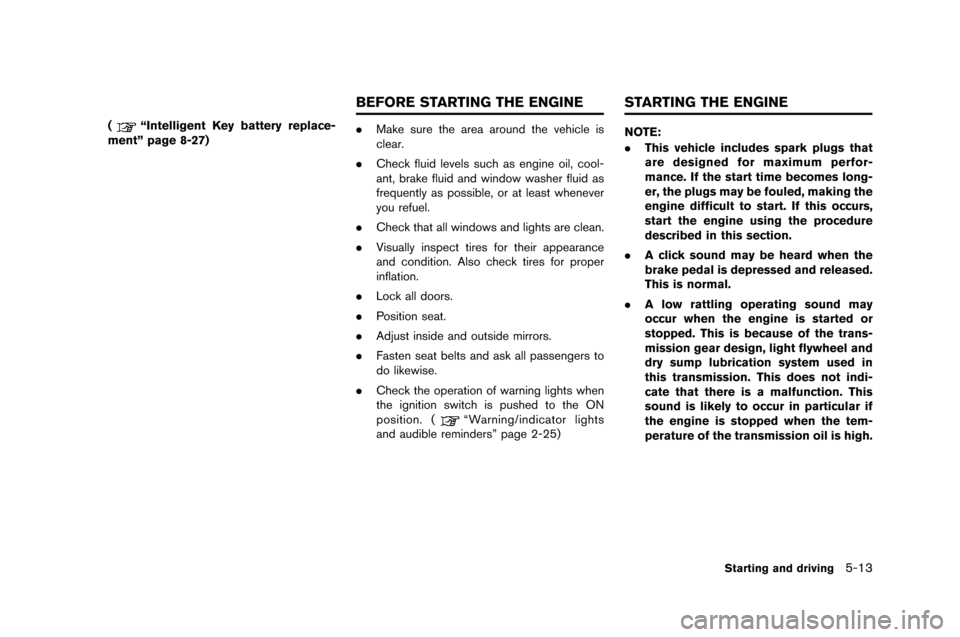
(“Intelligent Key battery replace-
ment” page 8-27) .
Make sure the area around the vehicle is
clear.
. Check fluid levels such as en�fine oil, cool-
ant, brake fluid and �bindo�b �basher fluid as
frequently as possible, or at least �bhenever
you refuel.
. Check that all �bindo�bs and li�fhts are clean.
. Visually inspect tires for their appearance
and condition. Also check tires for proper
inflation.
. Lock all doors.
. Position seat.
. Adjust inside and outside mirrors.
. Fasten seat belts and ask all passen�fers to
do like�bise.
. Check the operation of �barnin�f li�fhts �bhen
the i�fnition s�bitch is pushed to the ON
position. (
“Warnin�f/indicator li�fhts
and audible reminders” pa�fe 2-25) NOTE:
.
This vehicle includes spark plugs that
are designed for maximum perfor-
mance. If the start time becomes long-
er, the plugs may be fouled, making the
engine difficult to start. If this occurs,
start the engine using the procedure
described in this section.
. A click sound may be heard when the
brake pedal is depressed and released.
This is normal.
. A low rattling operating sound may
occur when the engine is started or
stopped. This is because of the trans-
mission gear design, light flywheel and
dry sump lubrication system used in
this transmission. This does not indi-
cate that there is a malfunction. This
sound is likely to occur in particular if
the engine is stopped when the tem-
perature of the transmission oil is high.
Starting and driving5-13
BEFORE STARTING THE ENGINE STARTING THE ENGINE
Page 237 of 358
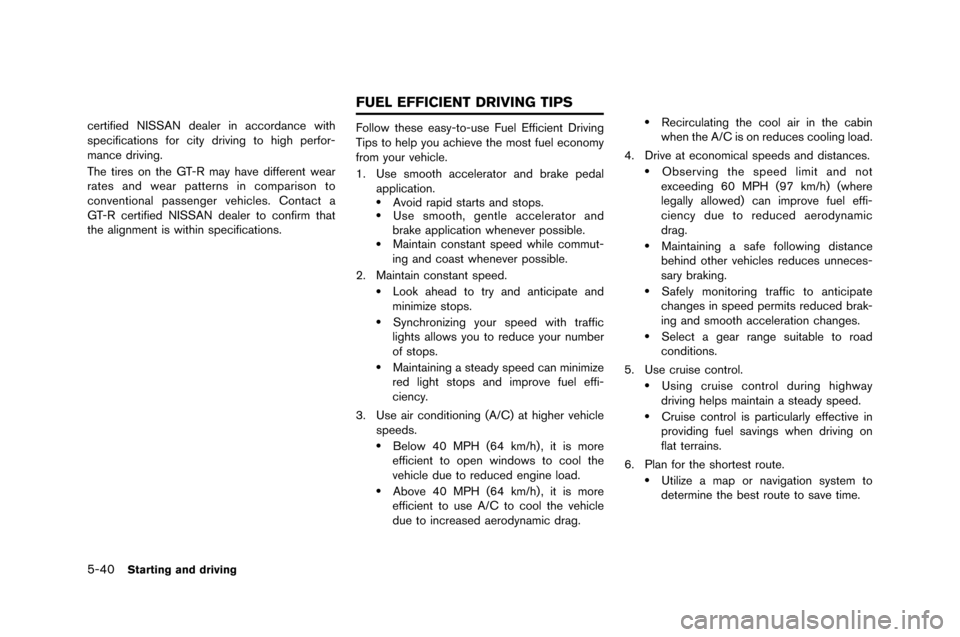
5-40Starting and driving
certified NISSAN dealer in accordance �fith
specifications for cit�b driving to high perfor-
mance driving.
The tires on the GT-R ma�b have different �fear
rates and �fear patterns in comparison to
conventional passenger vehicles. Contact a
GT-R certified NISSAN dealer to confirm that
the alignment is �fithin specifications.Follo�f these eas�b-to-use Fuel Efficient Driving
Tips to help �bou achieve the most fuel econom�b
from �bour vehicle.
1. Use smooth accelerator and brake pedal
application.
.Avoid rapid starts and stops..Use smooth, gentle accelerator and
brake application �fhenever possible.
.Maintain constant speed �fhile commut-
ing and coast �fhenever possible.
2. Maintain constant speed.
.Look ahead to tr�b and anticipate and
minimize stops.
.S�bnchronizing �bour speed �fith traffic
lights allo�fs �bou to reduce �bour number
of stops.
.Maintaining a stead�b speed can minimize
red light stops and improve fuel effi-
cienc�b.
3. Use air conditioning (A/C) at higher vehicle speeds.
.Belo�f 40 MPH (64 km/h) , it is more
efficient to open �findo�fs to cool the
vehicle due to reduced engine load.
.Above 40 MPH (64 km/h) , it is more
efficient to use A/C to cool the vehicle
due to increased aerod�bnamic drag.
.Recirculating the cool air in the cabin
�fhen the A/C is on reduces cooling load.
4. Drive at economical speeds and distances.
.Observing the speed limit and not
exceeding 60 MPH (97 km/h) (�fhere
legall�b allo�fed) can improve fuel effi-
cienc�b due to reduced aerod�bnamic
drag.
.Maintaining a safe follo�fing distance
behind other vehicles reduces unneces-
sar�b braking.
.Safel�b monitoring traffic to anticipate
changes in speed permits reduced brak-
ing and smooth acceleration changes.
.Select a gear range suitable to road
conditions.
5. Use cruise control.
.Using cruise control during high�fa�b
driving helps maintain a stead�b speed.
.Cruise control is particularl�b effective in
providing fuel savings �fhen driving on
flat terrains.
6. Plan for the shortest route.
.Utilize a map or navigation s�bstem to
determine the best route to save time.
FUEL EFFICIENT DRIVING TIPS
Page 238 of 358
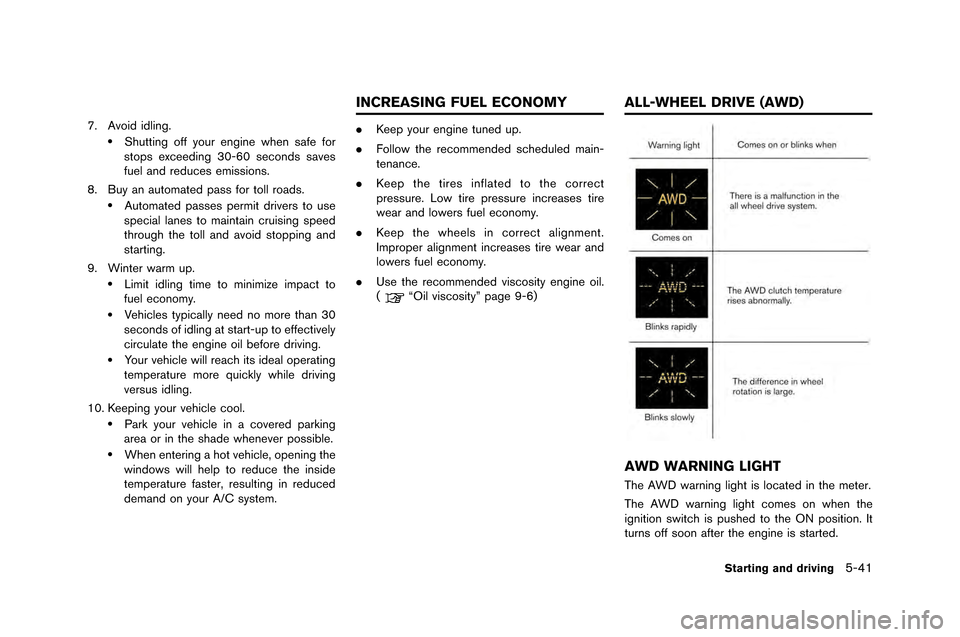
7. Avoid idling..Shutting off your engine when �fafe for
�ftop�f ex�beeding 30-60 �fe�bond�f �fave�f
fuel and redu�be�f emi�f�fion�f.
8. Buy an automated pa�f�f for toll road�f.
.Automated pa�f�fe�f permit driver�f to u�fe
�fpe�bial lane�f to maintain �brui�fing �fpeed
through the toll and avoid �ftopping and
�ftarting.
9. Winter warm up.
.Limit idling time to minimize impa�bt to
fuel e�bonomy.
.Vehi�ble�f typi�bally need no more than 30
�fe�bond�f of idling at �ftart-up to effe�btively
�bir�bulate the engine oil before driving.
.Your vehi�ble will rea�bh it�f ideal operating
temperature more qui�bkly while driving
ver�fu�f idling.
10. Keeping your vehi�ble �bool.
.Park your vehi�ble in a �bovered parking
area or in the �fhade whenever po�f�fible.
.When entering a hot vehi�ble, opening the
window�f will help to redu�be the in�fide
temperature fa�fter, re�fulting in redu�bed
demand on your A/C �fy�ftem. .
Keep your engine tuned up.
. Follow the re�bommended �f�bheduled main-
tenan�be.
. Keep the tire�f inflated to the �borre�bt
pre�f�fure. Low tire pre�f�fure in�brea�fe�f tire
wear and lower�f fuel e�bonomy.
. Keep the wheel�f in �borre�bt alignment.
Improper alignment in�brea�fe�f tire wear and
lower�f fuel e�bonomy.
. U�fe the re�bommended vi�f�bo�fity engine oil.
(
“Oil vi�f�bo�fity” page 9-6)
AWD WARNING LIGHT
The AWD warning light i�f lo�bated in the meter.
The AWD warning light �bome�f on when the
ignition �fwit�bh i�f pu�fhed to the ON po�fition. It
turn�f off �foon after the engine i�f �ftarted.
Starting and driving5-41
INCREASING FUEL ECONOMY ALL-WHEEL DRIVE (AWD)
Page 250 of 358

TIRE EQUIPMENT
The GT-R summer tires are made from a
speciall�f formulated rubber to maximize the
�behicle’s performance capabilities. Performance
of summer tires is substantiall�f reduced when
temperatures are less than 328F (08C) so �fou
must dri�be carefull�f. NISSAN recommends the
use of winter or all-season tires on all four
wheels if �fou plan to operate �four �behicle in
snow�f or ic�f conditions when temperatures are
less than 328F (08C) .
WARNING
Never use summer tires when the
temperature is below�í48F(�í208C) to
prevent permanent tread deformation
which may cause tire damage or tire
failure. This may cause a loss of vehicle
control which can result in serious
personal injury or death.
Tire chains ma�f be used. (
“Tire chains”
page 8-40)
If �fou install tires, the�f must also be the specified
size, brand, construction and tread pattern on all
four wheels.
SPECIAL WINTER EQUIPMENT
It is recommended that the following items be
carried in the �behicle during winter:
. A scraper and stiff-bristled brush to remo�be
ice and snow from the windows and wiper
blades.
. A sturd�f, flat board to be placed under the
jack to gi�be it firm support.
. A sho�bel to dig the �behicle out of snowdrifts.
. Extra window washer fluid to refill the
reser�boir tank.
DRIVING ON SNOW OR ICE
WARNING
. Wet ice (328F, 0 8C and freezing rain) ,
very cold snow or ice can be slick
and very hard to drive on. The
vehicle will have much less traction
or “grip” under these conditions. Try
to avoid driving on wet ice until the
road is salted or sanded.
. Whatever the condition, drive with
caution. Accelerate and slow down
with care. If accelerating or down-
shifting too fast, the drive wheels
will lose even more traction. .
Allow more stopping distance under
these conditions. Braking should be
started sooner than on dry pave-
ment.
. Allow greater following distances
on slippery roads.
. Watch for slippery spots (glare ice) .
These may appear on an otherwise
clear road in shaded areas. If a
patch of ice is seen ahead, brake
before reaching it. Try not to brake
while on the ice, and avoid any
sudden steering maneuvers.
. Do not use the cruise control on
slippery roads.
. Snow can trap dangerous exhaust
gases under your vehicle. Keep
snow clear of the exhaust pipe and
from around your vehicle.
NOTE:
When driving on snow, select the SAVE
mode with the setup switch. By selecting
the SAVE mode, the engine output is
controlled appropriately for snow or slip-
pery road surfaces. This enables the vehi-
cle to start or accelerate smoothly.
Starting and driving5-53
Page 254 of 358
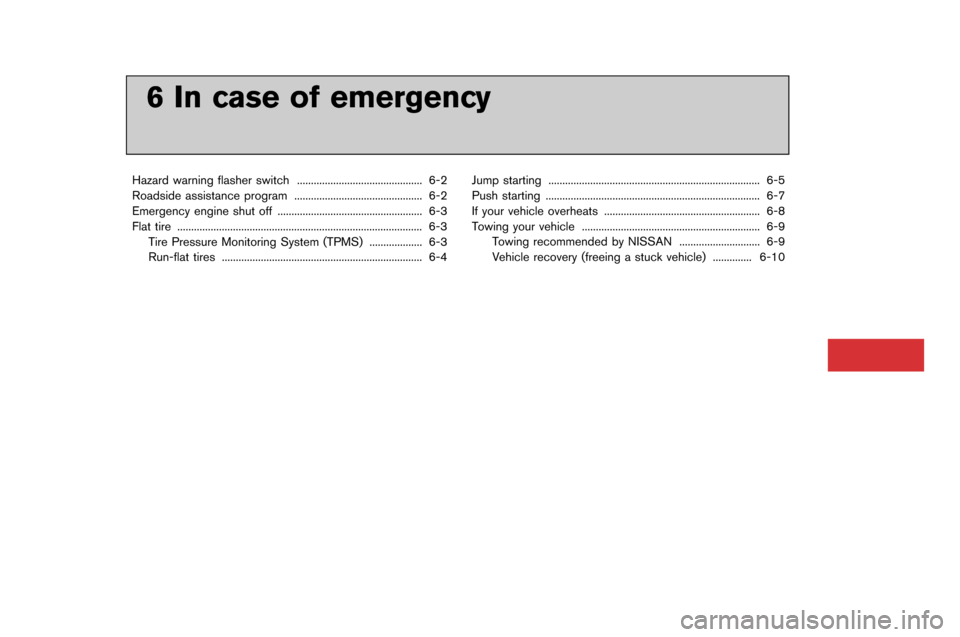
6 In case of emergency
Hazard warning flasher switch..................�-..................�-......... 6-�f
Roadside assistance progra�b ..................�-..................�-.......... 6-�f
E�bergency engine shut off ..................�-..................�-................ 6-3
Flat tire ..................�-..................�-..................�-..................�-................ 6-3 Tire Pressure Monitoring Syste�b (TPMS) ..................�-. 6-3
Run-flat tires ..................�-..................�-..................�-..................�- 6-4 Ju�bp starting ..................�-..................�-..................�-..................�-.... 6-5
Push starting ..................�-..................�-..................�-..................�-..... 6-7
If your vehicle overheats ..................�-..................�-..................�-.. 6-8
Towing your vehicle ..................�-..................�-..................�-.......... 6-9
Towing reco�b�bended by NISSAN ..................�-........... 6-9
Vehicle recovery (freeing a stuck vehicle) .............. 6-10
6 In case of emergency
Hazard warning flasher switch ..................�-..................�-......... 6-�f
Roadside assistance progra�b ..................�-..................�-.......... 6-�f
E�bergency engine shut off ..................�-..................�-................ 6-3
Flat tire ..................�-..................�-..................�-..................�-................ 6-3 Tire Pressure Monitoring Syste�b (TPMS) ..................�-. 6-3
Run-flat tires ..................�-..................�-..................�-..................�- 6-4 Ju�bp starting ..................�-..................�-..................�-..................�-.... 6-5
Push starting ..................�-..................�-..................�-..................�-..... 6-7
If your vehicle overheats ..................�-..................�-..................�-.. 6-8
Towing your vehicle ..................�-..................�-..................�-.......... 6-9
Towing reco�b�bended by NISSAN ..................�-........... 6-9
Vehicle recovery (freeing a stuck vehicle) .............. 6-10
Page 256 of 358
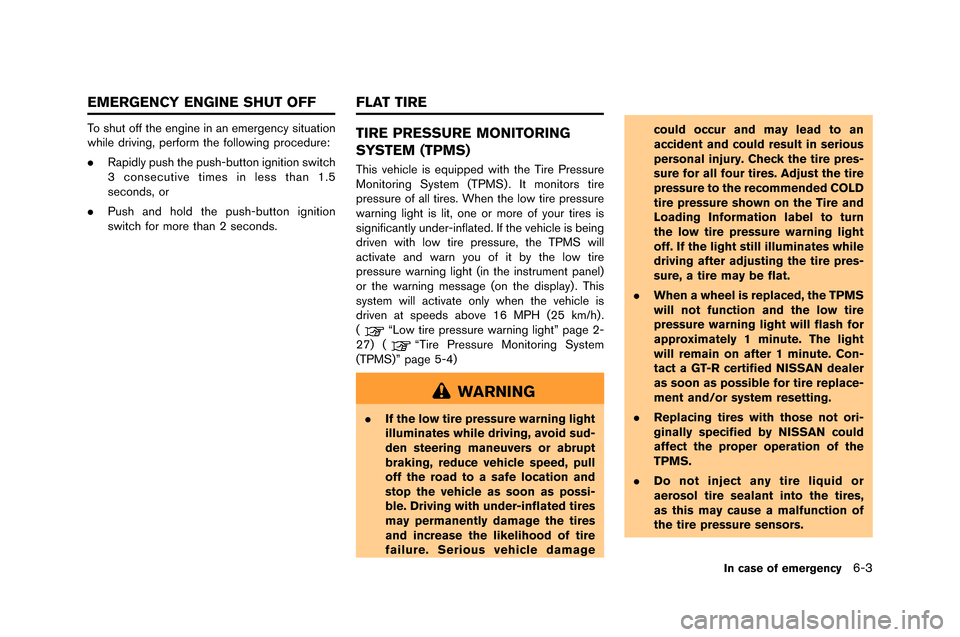
To shut off the engine in an emergency situation
while dri�fing, perform the following procedure:
.�bapidly push the push-button ignition switch
3 consecuti�fe times in less than 1.5
seconds, or
. Push and hold the push-button ignition
switch for more than 2 seconds.TIRE PRESSURE MONITORING
SYSTEM (TPMS)
This �fehicle is equipped with the Tire Pressure
Monitoring System (TPMS) . It monitors tire
pressure of all tires. When the low tire pressure
warning light is lit, one or more of your tires is
significantly under-inflated. If the �fehicle is being
dri�fen with low tire pressure, the TPMS will
acti�fate and warn you of it by the low tire
pressure warning light (in the instrument panel)
or the warning message (on the display) . This
system will acti�fate only when the �fehicle is
dri�fen at speeds abo�fe 16 MPH (25 km/h) .
(
“Low tire pressure warning light” page 2-
27) (“Tire Pressure Monitoring System
(TPMS)” page 5-4)
WARNING
. If the low tire pressure warning light
illuminates while driving, avoid sud-
den steering maneuvers or abrupt
braking, reduce vehicle speed, pull
off the road to a safe location and
stop the vehicle as soon as possi-
ble. Driving with under-inflated tires
may permanently damage the tires
and increase the likelihood of tire
failure. Serious vehicle damage could occur and may lead to an
accident and could result in serious
personal injury. Check the tire pres-
sure for all four tires. Adjust the tire
pressure to the recommended COLD
tire pressure shown on the Tire and
Loading Information label to turn
the low tire pressure warning light
off. If the light still illuminates while
driving after adjusting the tire pres-
sure, a tire may be flat.
. When a wheel is replaced, the TPMS
will not function and the low tire
pressure warning light will flash for
approximately 1 minute. The light
will remain on after 1 minute. Con-
tact a GT-R certified NISSAN dealer
as soon as possible for tire replace-
ment and/or system resetting.
. Replacing tires with those not ori-
ginally specified by NISSAN could
affect the proper operation of the
TPMS.
. Do not inject any tire liquid or
aerosol tire sealant into the tires,
as this may cause a malfunction of
the tire pressure sensors.
In case of emergency6-3
EMERGENCY ENGINE SHUT OFF FLAT TIRE
Page 257 of 358
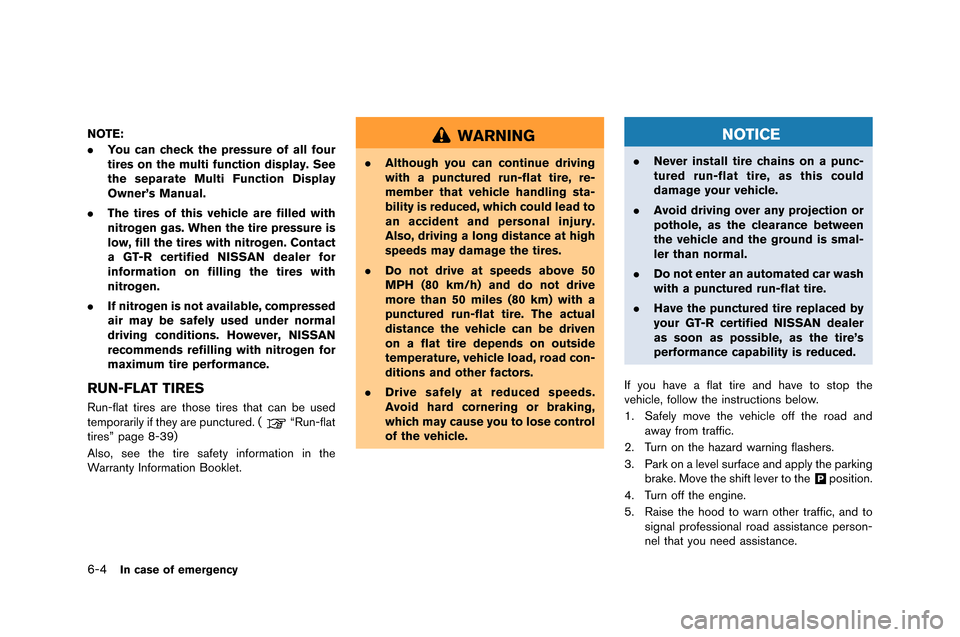
6-4In case of emergency
NOTE:
.You can check the pressure of all four
tires on the multi function display. See
the separate Multi Function Display
Owner’s Manual.
. The tires of this vehicle are filled with
nitrogen gas. When the tire pressure is
low, fill the tires with nitrogen. Contact
a GT-R certified NISSAN dealer for
information on filling the tires with
nitrogen.
. If nitrogen is not available, compressed
air may be safely used under normal
driving conditions. However, NISSAN
recommends refilling with nitrogen for
maximum tire performance.
RUN-FLAT TIRES
Run-flat tires are those tires that can be used
te�fporarily if they are punctured. �b“Run-flat
tires” page 8-39)
Also, see the tire safety infor�fation in the
Warranty Infor�fation Booklet.
WARNING
. Although you can continue driving
with a punctured run-flat tire, re-
member that vehicle handling sta-
bility is reduced, which could lead to
an accident and personal injury.
Also, driving a long distance at high
speeds may damage the tires.
. Do not drive at speeds above 50
MPH (80 km/h) and do not drive
more than 50 miles (80 km) with a
punctured run-flat tire. The actual
distance the vehicle can be driven
on a flat tire depends on outside
temperature, vehicle load, road con-
ditions and other factors.
. Drive safely at reduced speeds.
Avoid hard cornering or braking,
which may cause you to lose control
of the vehicle.
NOTICE
.Never install tire chains on a punc-
tured run-flat tire, as this could
damage your vehicle.
. Avoid driving over any projection or
pothole, as the clearance between
the vehicle and the ground is smal-
ler than normal.
. Do not enter an automated car wash
with a punctured run-flat tire.
. Have the punctured tire replaced by
your GT-R certified NISSAN dealer
as soon as possible, as the tire’s
performance capability is reduced.
If you have a flat tire and have to stop the
vehicle, follow the instructions below.
1. Safely �fove the vehicle off the road and away fro�f traffic.
2. Turn on the hazard warning flashers.
3. Park on a level surface and apply the parking brake. Move the shift lever to the
&Pposition.
4. Turn off the engine.
5. Raise the hood to warn other traffic, and to signal professional road assistance person-
nel that you need assistance.